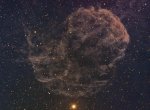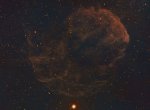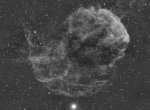Hi Julian
This 'salmon pink' problem is typically caused by poorly adapted luminance and chrominance components before LRGB combination. The pink color results from too high luminance values, since the excess of luminance tends to desaturate the final image.
You can match the fluxes between RGB and L with the LinearFit tool (description excerpted from
this thread, which I recommend you read for more detailed information on key topics):
- Apply the initial nonlinear histogram transformations to RGB and L. Adjust the L image first, to the desired brightness and contrast. Then try to match the overall illumination of L when you transform RGB. Do it roughly by eye using the CIE L* display mode (Shift+Ctrl+L, Shift+Cmd+L on the Mac). Don't try to do a particularly accurate work here; we'll do much better in the next steps.
- Extract the CIE L* component of RGB with the ChannelExtraction tool (select the CIE L*a*b* space, uncheck a* and b*, and apply to RGB).
- Open the LinearFit tool (ColorCalibration category) and select the L image as the reference image. Apply to the L* component of RGB that you have extracted in the previous step.
- Reinsert the fitted L* in the RGB image with the ChannelCombination tool.
Now your RGB and L images have been matched very accurately. Use the LRGBCombination tool with them. You shouldn't change the luminance transfer function, neither the channel weights, as LinearFit has already done the matching job much better than anything you could do manually.
An alternative way to match RGB and L accurately is using the ScreenTransferFunction tool (STF). You apply the automatic screen stretch function to both RGB and L (clicking the 'A' button on STF), then transfer the STF instance to HistogramTransformation (HT) by dragging the blue triangle from STF to HT's control bar. Apply HT. Since STF's automatic stretch is based on image statistics, in this way both images will be stretched in a similar way.
Let me know if this improves your results.



